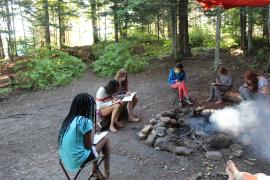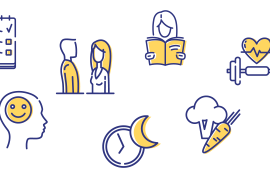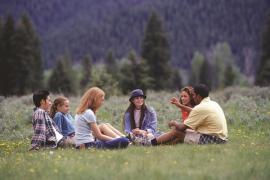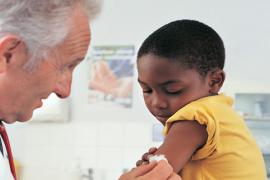In 2021, the Anxiety and Depression Association of America reported that approximately 18.1 percent of adults (those 18 years and older) and 25.1 percent of adolescents (13–18 years) experienced anxiety challenges regularly. During the same year, the CDC said that almost 20 percent of youth reported seriously contemplating suicide (CDC, 2021).
Camp leaders are born problem-solvers, so when we feel underprepared, or even incapable of helping campers and staff as they struggle with higher levels of anxiety, depression, or other mental health problems, it can leave us feeling overwhelmed, exhausted, and even demoralized. We may also feel torn between what we see as our responsibility to support campers or staff in crisis and our comfort zone or “scope of practice,” which does not include diagnosis or treatment of mental health disorders.
How can we feel more capable and confident as leaders while also “leveling up” (as the kids say) the quality of our support for campers and staff? If they need camp more than ever, then we need a more functional mindset and a more effective skill set, based on our strengths but also within our limits as camp professionals rather than mental health professionals. Let’s look at a more useful framework for understanding mental health at camp and then dig into a few of the tools we can use to support both kids and adults.
The Problem with the Term “Mental Health”
Let’s begin by breaking down the term “mental health” before shifting to a better one. Using this term as a catchall for the quality of our psychological functioning is problematic because it doesn’t acknowledge the breadth of factors affecting us. It also carries negative connotations that can cause us to recoil rather than lean in.
Over the past decade, the broadened description of mental, emotional, and social health — which has been championed by the Alliance for Camp Health (formerly the Association of Camp Nursing) and ACA — has helped move the conversation forward.
Our “mental health” is composed of many different factors including our thoughts, feelings, perceptions, and behaviors. Each of these factors have multiple characteristics that can be measured along spectrums. For example, visualize a line from 0 to 10 and choose a feeling such as anger, fear, or sadness. Now measure that feeling according to these characteristics:
- Intensity — how strong it is
- Frequency — how often it occurs
- Duration — how long it lasts
All of these mental health factors (along with their individual characteristics) are dynamic, changing and moving along these spectrums over time. They are also interconnected, affecting each other in various ways, sometimes by reinforcing one another and other times counteracting each other.
Some of these factors are internal — in our mind and throughout our body — including the biochemistry of neurotransmitters and hormones produced in our nervous system, endocrine system, and even by bacteria in our gut (which has as many nerve cells as our spinal cord) (Mayer, 2016). Other factors are external — in our environment — including our social interactions with other people, the characteristics of our living environments, and even the weather.
We have agency over some of these factors and can affect them through the choices we make — taking medications to affect neurotransmitters or participating in therapy to process past traumatic experiences, for example. Other factors are outside of our individual control, such as a genetic predisposition or society-level stressors like climate change or systemic inequalities.
As a whole, these points combine to paint a picture of “mental health” that is complicated, messy, and beyond our scope of practice as camp directors. Instead of getting caught in the weeds of mental health, though, we can choose a more functional focus: How are campers and staff doing at camp right now, and what can we do to help them do better while they are in our care?
The Power of Well-Being
Instead of using the term “mental health” when describing the functioning of our campers and staff, we can shift to using “well-being.” Not only is this term less clinical and overwhelming, but it more appropriately captures the many different factors that comprise our functioning. Even when we called it “mental health,” there were contributing factors beyond the mental or psychological. Consider physical factors such as exercise and sleep; social factors such as relationships; and spiritual factors such as prayer, meditation, or contributing to a purpose greater than ourselves. All of these dynamic and interconnected factors are aspects of our well-being and deserve to be considered in our efforts to support campers and staff; to help them feel better when they are struggling or suffering.
Comparing Mental Health to Well-Being
To be a mental health professional one must undergo specific education, training, and certification. The goal of treatment by a mental health professional is to heal or fix the presenting problem through some process of change. To do so, the professional will conduct “sessions” that are structured and require certain documentation and informed consent. Professionals will conduct some type of assessment, often gathering lots of information about personal, family, and medical history. After analyzing all this information, they may arrive at a diagnosis and then plan a course of treatment to progress over a period of time.
As camp professionals, all of these things are beyond our scope of practice. And that’s OK, because our goal is not to diagnose or treat; our goal is to connect and support. What we can do at camp is to join with the camper or staff member who is struggling. Stay present in the moment, and let them know they are not alone. Instead of judging or analyzing them, we can stay curious about what is potentially causing them to struggle and then support them in making adjustments to feel better. Not only does this keep us within our scope of practice as camp professionals, but it fulfills our most basic mission: to support the development of those in our care by overcoming the obstacles and challenges they face at camp.
It is important to note here that you may feel uncomfortable or unsafe supporting someone at camp, even when acting within your scope of practice as a camp professional. If so, get help. There is no standard behavior or statement that a person may do or say to let you know the situation requires a higher level of support. Every situation is unique, and it’s your responsibility to judge whether you need help to respond to it appropriately. If you feel that a situation is beyond your capacity or skill set, get help.
It’s best to know where that help would come from before you need it. Identify the people at camp who would come to your aid or the phone numbers of outside support, should you need to access professionals who are not onsite. Then you can access help as soon as possible when you need it.
Tools for Supporting Well-Being
Now that we’ve shifted to a new mindset around well-being at camp, let’s dig into some tools for actually supporting campers and staff. Because we’ve moved away from the term “mental health,” we can shift attention away from conceptions of disorders or diagnoses. Instead, we will focus on how well campers and staff are functioning at camp. And if they are struggling or suffering, how we can support them to feel better while they are with us.
Prevention
Let’s start by looking at what we can do to create a camp environment that maximizes well-being from the very beginning. By doing so, we may prevent situations from escalating to the point of crisis, where we need to intervene with a camper or staff experiencing an emotional breakdown.
Rick Hanson, PhD, a psychologist and senior fellow at the Greater Good Science Center at UC Berkeley, organizes our basic human needs into three categories: safety, satisfaction, and connection (Hanson, 2016). This framework is well-suited to the camp environment and provides us with a useful lens to analyze our programs. Any time these needs go unmet at camp, it will manifest as stressors, decreasing the well-being of our campers and staff.
Everyone needs to feel physically and emotionally safe at camp. When we feel threatened or at risk of being hurt, our amygdala overwhelms our executive functioning causing us to be reactive instead of receptive (Siegel and Bryson, 2011). Add “safe-to-fail” under this category as well. Camps that do a great job of minimizing the fear of failure for campers and staff, whether in activities or social situations, reduce the stressors of pressure and anxiety.
Hanson describes satisfaction as our ability to have enough of the “basics,” such as food, sleep, shelter, comfort, and, for adults, money. He adds to this the ability to approach things that bring us happiness, such as hobbies. If campers and staff are not getting enough food, sleep, or protection from the elements, well-being goes down.
Connection can encompass many nuances of our social relationships and interactions with others. We all desire to be understood and accepted for who we are, to be included in groups, to feel a sense of belonging in places and spaces that matter to us, and to be recognized and appreciated. We know that camp can be the best place for campers and staff to experience these connections, often more so than home, school, or other activities. But when people do not feel these connections at camp, stressors manifest and well-being is negatively affected.
If you assess your camp environment through the lens of these basic needs, you may find that the areas where you are falling short result in the most powerful stressors negatively affecting campers and staff. Or you can reverse engineer that assessment by finding the places where campers or staff experience the most stressors and then asking which basic needs are not being met. Meeting these needs better will reduce the need to intervene with campers and staff in crisis, because the reduction of stressors will improve their overall well-being.
Intervention
Connection will serve as the bridge between prevention and intervention as we move from meeting needs in a more general way to supporting someone in a specific moment of crisis. Connection is critical for both.
The foundation of good work with people is the quality of the relationship (or connection) between them. We know this instinctively at camp, but the mental health world knows it too. In fact, across all different types (or modalities) of therapy, the most important factor in determining whether clients get better is the quality of their relationship with the therapist (Knoblach-Fedders, 2008). In the mental health field, we might even say that the relationship is where the healing takes place. And although we aren’t doing therapy at camp, high-quality professional relationships are still how our best work gets done.
This begins with authenticity, trust, and a genuine commitment to the best interest of the person we’re supporting. It is best if you’ve been able to start building this before intervention is required with a camper or staff, but you can also successfully build the plane while taking off, if the situation requires it.
Let’s use the simple visual of a balance scale. On one side we have the stressors — often needs that are unmet, as discussed earlier — but really anything at all that decreases well-being. Like all factors that affect our well-being, these are dynamic, interconnected, and exist on spectrums — from mild anxiety about being in a new place to intense emotional abuse at the hands of a bully.
On the other side we have coping mechanisms, the factors that offset stressors and increase our well-being. These can be divided into categories of healthy and unhealthy mechanisms based on their longer-term effects on our health. Many of the unhealthy coping mechanisms are quite effective, and we use them often (I tend to “stress eat” fun-sized candy, for example). It’s just that they may not serve our long-term interests.
If there are only two sides of this balance scale, and we are supporting someone in need of improved well-being, then we can either decrease stressors or increase coping mechanisms. Helping people to assess the problem at hand (without digging into their past or their psychology) is our path forward.
Not all of the stressors affecting us at camp are within our ability to change, so we must choose to focus on the ones we can affect. Let’s ask, “What might be causing your distress right now?” or, “What happened before you became upset?” Perhaps we’ll uncover a trigger or stressor that we can then try to minimize or remove. If that’s not possible, what coping mechanisms might work for this camper or staff member, considering their needs and abilities as well as the context of the camp structure and environment?
Seeking to reduce stressors and increase coping mechanisms is our effort to improve well-being in the moment. But we don’t want to miss the opportunity to also increase the sense of connection that helps people to feel better, especially when our adjustments may not “fix” the presenting problem entirely. Let’s picture another spectrum with “fixing” on one end and “holding” on the other. Holding is our ability to sit with someone who is suffering without judgment. If we give our full attention as we listen to them, then validate and normalize their experience (“It’s OK to feel overwhelmed by these difficult feelings” and “It’s normal to feel this way; lots of us do at times.”) we provide needed emotional support within our scope of practice as camp professionals. “I may not be able to fix this, but you are not alone, and I’m here to support you through it.”
As John Hamilton, chief strategy and engagement officer at the Alliance for Camp Health, so aptly put it: “Adversity cannot always be conquered, fixed, or resolved, but it can be heard, held, and loved.”
Photo courtesy of West End House Girls Camp, Parsonsfield, ME.
References
Anxiety and Depression Association of America (2021). Facts and statistics. adaa.org/understanding-anxiety/facts-statistics
Centers for Disease Control and Prevention (2021). Coping with stress. cdc.gov/mentalhealth/stress-coping/cope-with-stress/index.html
Hamilton, J. and Gaslin, T. (2022). MESH Mechanics That Spur Personal Development in Campers and Staff. American Camp Association Camping Magazine. ACAcamps.org/article/camping-magazine/mesh-mechanics-spur-personal-development-campers-staff
Hanson, R. (2018). Resilient: How to grow an unshakable core of calm, strength, and happiness. New York, NY: Harmony Books.
Knoblach-Fedders, L. (2008). The importance of the relationship with the therapist. Clinical Science Insights, Vol.1.: family-institute.org/behavioral-health-resources/importance-relationship-therapist
Mayer, E. (2016) The mind-gut connection. New York, NY: HarperCollins.
Siegel, D. and Bryson, T. (2011). The whole-brain child. New York, NY: Bantam Books.
Dave Brown is a licensed clinical social worker who has worked in nonprofits, public schools, and, since 2010, as a director for Mountain Camp near Lake Tahoe, California. At camp, he supports staff and camper mental health, well-being, and development. Outside of camp, he runs Fence Post Learning, an online staff training resource, and maintains a small telehealth therapy practice from his home in the Bay Area. Learn more at davebrownlcsw.com.





